2004 SUBARU IMPREZA WRX service
[x] Cancel search: servicePage 4 of 491

1
–
CONTINUED –
Warranties !Warranties for U.S.A.
All SUBARU vehicles distributed by Subaru of Ameri-
ca, Inc. and sold at retail by an authorized SUBARU
dealer in the United States come with the following
warranties: " SUBARU Limited Warranty
" Emission Control Systems Warranty
" Emissions Performance Warranty
All warranty information, including details of coverage
and exclusions, is in the “Warranty and Maintenance
Booklet”. Please read these warranties carefully. ! Warranties for Canada
All SUBARU vehicles distributed by Subaru Canada,
Inc. and sold at retail by an authorized SUBARU deal-
er in Canada come with the following warranties: " SUBARU Limited Warranty
" Anti-Corrosion Warranty
" Emission Control Warranty
All warranty information, including details of coverage
and exclusions, is in the Warranty and Service Book-
let. Please read these warranties carefully. !
WRX-STi (U.S. model only)
WRX-STi models are equipped with High Intensity
Discharge (HID) headlights that contain mercury.
For that reason, it is necessary to remove HID
headlights before vehicle disposal. Once re-
moved, please reuse, recycle or dispose of the HID
headlights as hazardous waste. !All models except U.S. model WRX-STi
This vehicle does not contain mercury devices or
parts.
Page 5 of 491

2
How to use this owner’s manual !Using your Owner’s manual
Before you operate your vehicle, carefully read this
manual. To protect yourself and extend the service life
of your vehicle, follow the instructions in this manual.
Failure to observe these instructions may result in se-
rious injury and damage to your vehicle.
This manual is composed of fourteen chapters. Each
chapter begins with a brief table of contents, so you
can usually tell at a glance if that chapter contains the
information you want.
Chapter 1: Seat, seatbelt and SRS airbags
This chapter informs you how to use the seat and seat-
belt and contains precautions for the SRS airbags.
Chapter 2: Keys and doors
This chapter informs you how to operate the keys,
locks and windows.
Chapter 3: Instruments and controls
This chapter informs you about the operation of instru-
ment panel indicators and how to use the instruments
and other switches.
Chapter 4: Climate Control
This chapter informs you how to operate the climate
control.
Chapter 5: Audio This chapter informs you how to operate your audio system.
Chapter 6: Interior equipment
This chapter informs you how to operate interior
equipment.
Chapter 7: Starting and operating
This chapter informs you how to start and operate your SUBARU.
Chapter 8: Driving tips
This chapter informs you how to drive your SUBARU
in various conditions and explains some safety tips on
driving.
Chapter 9: In case of emergency
This chapter informs you what to do if you have a prob-
lem while driving, such as a flat tire or engine over-
heating.
Chapter 10: Appearance care
This chapter informs you how to keep your SUBARU
looking good.
Chapter 11: Maintenance and service
This chapter informs you when you need to take your
SUBARU to the dealer for scheduled maintenance
and informs you how to keep your SUBARU running
properly.
Chapter 12: Specifications
This chapter informs you about dimension and capac-
ities of your SUBARU.
Page 16 of 491

14
9
12
8
1
2
3
4
5
6
7
13
10
11
Table of contentsSeat, seatbelt and SRS airbags
Keys and doors
Instruments and controls
Climate controlAudio
Interior equipment
Starting and operating
Driving tips
In case of emergency
Appearance care
Maintenance and service
Specifications
Consumer information and Reporting safety defects
Index
Page 55 of 491
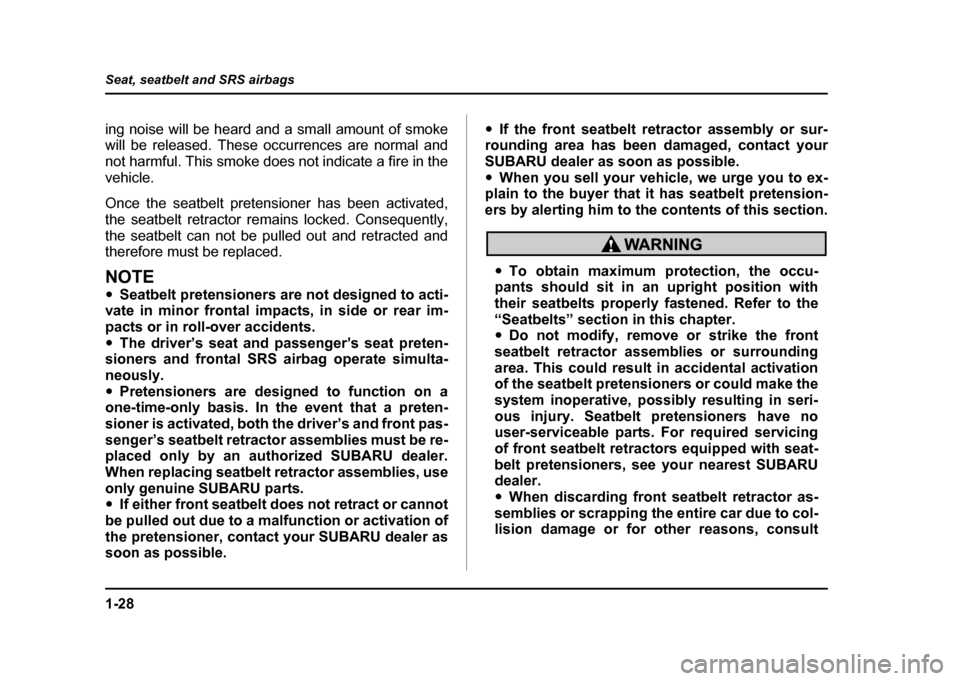
1-28
Seat, seatbelt and SRS airbags
ing noise will be heard and a small amount of smoke
will be released. These occurrences are normal and
not harmful. This smoke does not indicate a fire in the
vehicle.
Once the seatbelt pretensioner has been activated,
the seatbelt retractor remains locked. Consequently,
the seatbelt can not be pulled out and retracted and
therefore must be replaced.
NOTE "
Seatbelt pretensioners are not designed to acti-
vate in minor frontal impacts, in side or rear im-
pacts or in roll-over accidents. " The driver’s seat and passenger’s seat preten-
sioners and frontal SRS airbag operate simulta-
neously." Pretensioners are designed to function on a
one-time-only basis. In the event that a preten-
sioner is activated, both the driver’s and front pas-
senger’s seatbelt retractor assemblies must be re-
placed only by an authorized SUBARU dealer.
When replacing seatbelt retractor assemblies, use
only genuine SUBARU parts. " If either front seatbelt does not retract or cannot
be pulled out due to a malfunction or activation of
the pretensioner, contact your SUBARU dealer as
soon as possible. "
If the front seatbelt retractor assembly or sur-
rounding area has been damaged, contact your
SUBARU dealer as soon as possible." When you sell your vehicle, we urge you to ex-
plain to the buyer that it has seatbelt pretension-
ers by alerting him to the contents of this section." To obtain maximum protection, the occu-
pants should sit in an upright position with
their seatbelts properly fastened. Refer to the
“Seatbelts” section in this chapter. " Do not modify, remove or strike the front
seatbelt retractor assemblies or surrounding
area. This could result in accidental activation
of the seatbelt pretensioners or could make the
system inoperative, possibly resulting in seri-
ous injury. Seatbelt pretensioners have no
user-serviceable parts. For required servicing
of front seatbelt retractors equipped with seat-
belt pretensioners, see your nearest SUBARU
dealer. " When discarding front seatbelt retractor as-
semblies or scrapping the entire car due to col-
lision damage or for other reasons, consult
Page 57 of 491
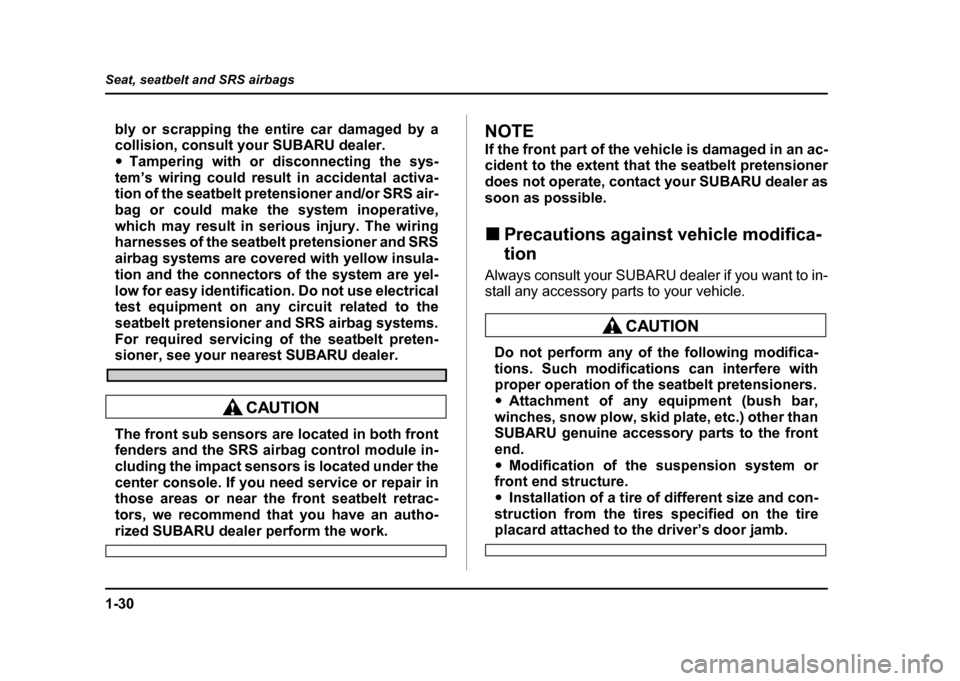
1-30
Seat, seatbelt and SRS airbags
bly or scrapping the entire car damaged by a
collision, consult your SUBARU dealer. "
Tampering with or disconnecting the sys-
tem’s wiring could result in accidental activa-
tion of the seatbelt pretensioner and/or SRS air-
bag or could make the system inoperative,
which may result in serious injury. The wiring
harnesses of the seatbelt pretensioner and SRS
airbag systems are covered with yellow insula-
tion and the connectors of the system are yel-
low for easy identification. Do not use electrical
test equipment on any circuit related to the
seatbelt pretensioner and SRS airbag systems.
For required servicing of the seatbelt preten-
sioner, see your nearest SUBARU dealer.
The front sub sensors are located in both front
fenders and the SRS airbag control module in-
cluding the impact sensors is located under the
center console. If you need service or repair in
those areas or near the front seatbelt retrac-
tors, we recommend that you have an autho-
rized SUBARU dealer perform the work.
NOTE
If the front part of the vehicle is damaged in an ac-
cident to the extent that the seatbelt pretensioner
does not operate, contact your SUBARU dealer as
soon as possible. ! Precautions against vehicle modifica- tion
Always consult your SUBARU dealer if you want to in-
stall any accessory parts to your vehicle.
Do not perform any of the following modifica-
tions. Such modifications can interfere with
proper operation of the seatbelt pretensioners. " Attachment of any equipment (bush bar,
winches, snow plow, skid plate, etc.) other than
SUBARU genuine accessory parts to the front
end." Modification of the suspension system or
front end structure." Installation of a tire of different size and con-
struction from the tires specified on the tire
placard attached to the driver’s door jamb.
Page 100 of 491
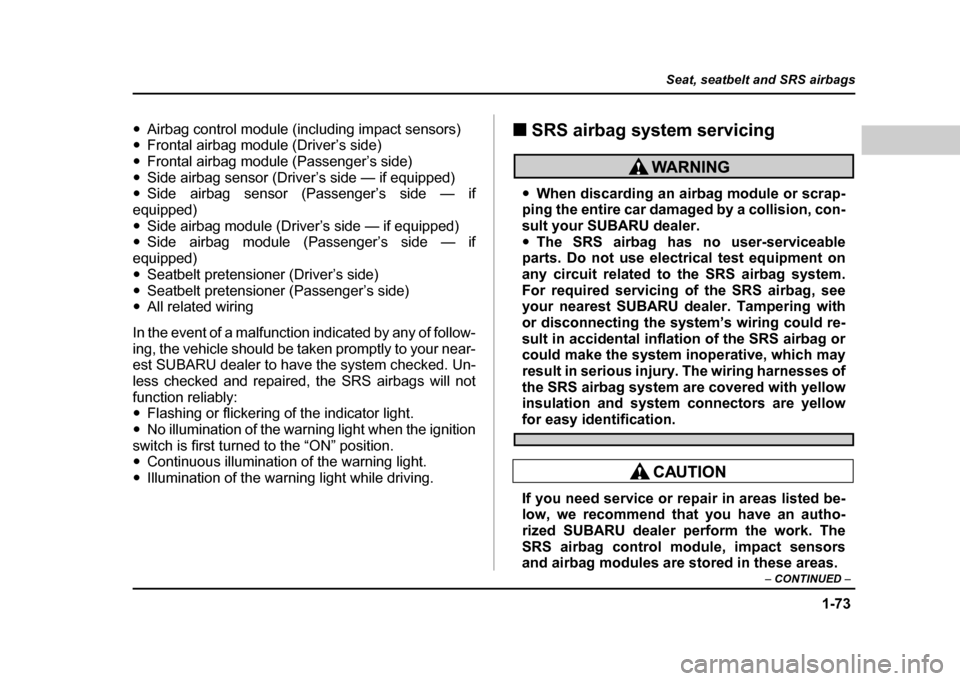
1-73
Seat, seatbelt and SRS airbags
– CONTINUED –
"Airbag control module (including impact sensors)
" Frontal airbag module (Driver’s side)
" Frontal airbag module (Passenger’s side)
" Side airbag sensor (Driver’s side — if equipped)
" Side airbag sensor (Passenger’s side — if
equipped) " Side airbag module (Driver’s side — if equipped)
" Side airbag module (Passenger’s side — if
equipped)" Seatbelt pretensioner (Driver’s side)
" Seatbelt pretensioner (Passenger’s side)
" All related wiring
In the event of a malfunction indicated by any of follow-
ing, the vehicle should be taken promptly to your near-
est SUBARU dealer to have the system checked. Un-
less checked and repaired, the SRS airbags will not
function reliably: " Flashing or flickering of the indicator light.
" No illumination of the warning light when the ignition
switch is first turned to the “ON” position." Continuous illumination of the warning light.
" Illumination of the warning light while driving. !
SRS airbag system servicing
"When discarding an airbag module or scrap-
ping the entire car damaged by a collision, con-
sult your SUBARU dealer." The SRS airbag has no user-serviceable
parts. Do not use electrical test equipment on
any circuit related to the SRS airbag system.
For required servicing of the SRS airbag, see
your nearest SUBARU dealer. Tampering with
or disconnecting the system’s wiring could re-
sult in accidental inflation of the SRS airbag or
could make the system inoperative, which may
result in serious injury. The wiring harnesses of
the SRS airbag system are covered with yellow
insulation and system connectors are yellow
for easy identification.
If you need service or repair in areas listed be-
low, we recommend that you have an autho-
rized SUBARU dealer perform the work. The
SRS airbag control module, impact sensors
and airbag modules are stored in these areas.
Page 159 of 491
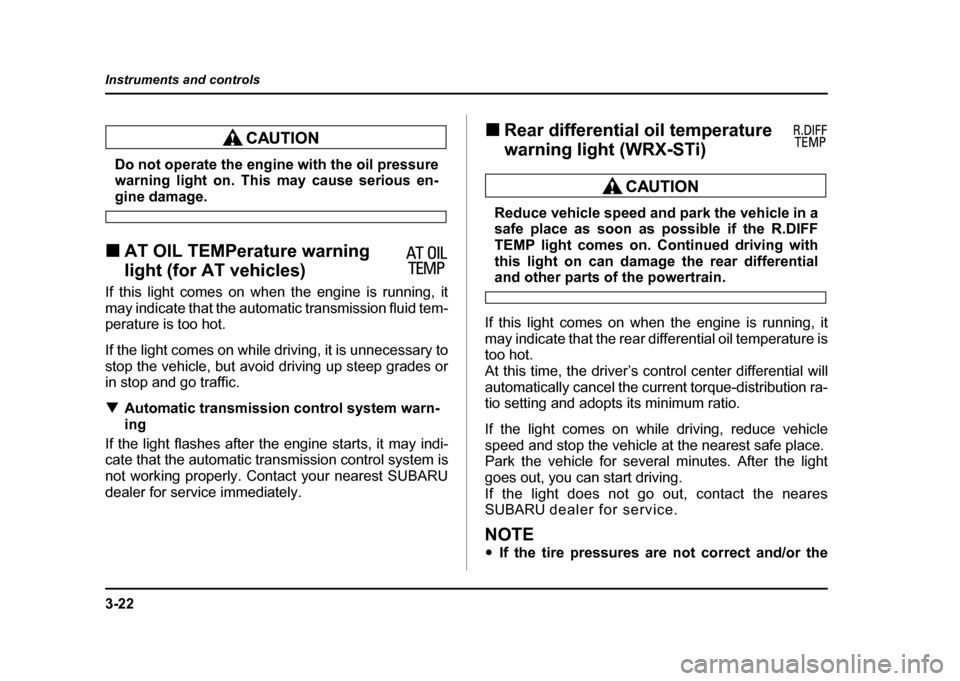
3-22
Instruments and controls
Do not operate the engine with the oil pressure
warning light on. This may cause serious en-
gine damage.
! AT OIL TEMPerature warning
light (for AT vehicles)
If this light comes on when the engine is running, it
may indicate that the automatic transmission fluid tem-
perature is too hot.
If the light comes on while driving, it is unnecessary to
stop the vehicle, but avoid driving up steep grades or
in stop and go traffic. ! Automatic transmission control system warn-
ing
If the light flashes after the engine starts, it may indi-
cate that the automatic transmission control system is
not working properly. Contact your nearest SUBARU
dealer for service immediately. !
Rear differential oil temperature
warning light (WRX-STi)
Reduce vehicle speed and park the vehicle in a
safe place as soon as possible if the R.DIFF
TEMP light comes on. Continued driving with
this light on can damage the rear differential
and other parts of the powertrain.
If this light comes on when the engine is running, it
may indicate that the rear differential oil temperature is
too hot.
At this time, the driver’s control center differential will
automatically cancel the current torque-distribution ra-
tio setting and adopts its minimum ratio.
If the light comes on while driving, reduce vehicle
speed and stop the vehicle at the nearest safe place.
Park the vehicle for several minutes. After the light
goes out, you can start driving.
If the light does not go out, contact the neares
SUBARU dealer for service.
NOTE " If the tire pressures are not correct and/or the
Page 209 of 491
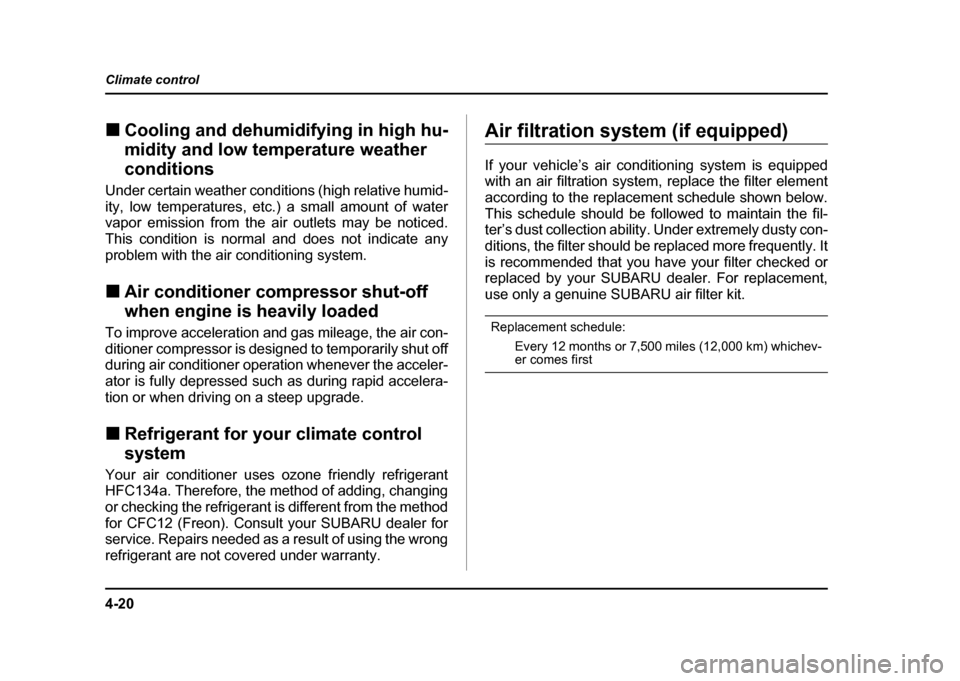
4-20
Climate control
!
Cooling and dehumidifying in high hu-
midity and low temperature weather
conditions
Under certain weather conditions (high relative humid-
ity, low temperatures, etc.) a small amount of water
vapor emission from the air outlets may be noticed.
This condition is normal and does not indicate any
problem with the air conditioning system. ! Air conditioner compressor shut-off
when engine is heavily loaded
To improve acceleration and gas mileage, the air con-
ditioner compressor is designed to temporarily shut off
during air conditioner operation whenever the acceler-
ator is fully depressed such as during rapid accelera-
tion or when driving on a steep upgrade. ! Refrigerant for your climate control
system
Your air conditioner uses ozone friendly refrigerant
HFC134a. Therefore, the method of adding, changing
or checking the refrigerant is different from the method
for CFC12 (Freon). Consult your SUBARU dealer for
service. Repairs needed as a result of using the wrong
refrigerant are not covered under warranty.Air filtration system (if equipped)
If your vehicle’s air conditioning system is equipped
with an air filtration system, replace the filter element
according to the replacement schedule shown below.
This schedule should be followed to maintain the fil-
ter’s dust collection ability. Under extremely dusty con-
ditions, the filter should be replaced more frequently. It
is recommended that you have your filter checked or
replaced by your SUBARU dealer. For replacement,
use only a genuine SUBARU air filter kit.
Replacement schedule: Every 12 months or 7,500 miles (12,000 km) whichev-
er comes first